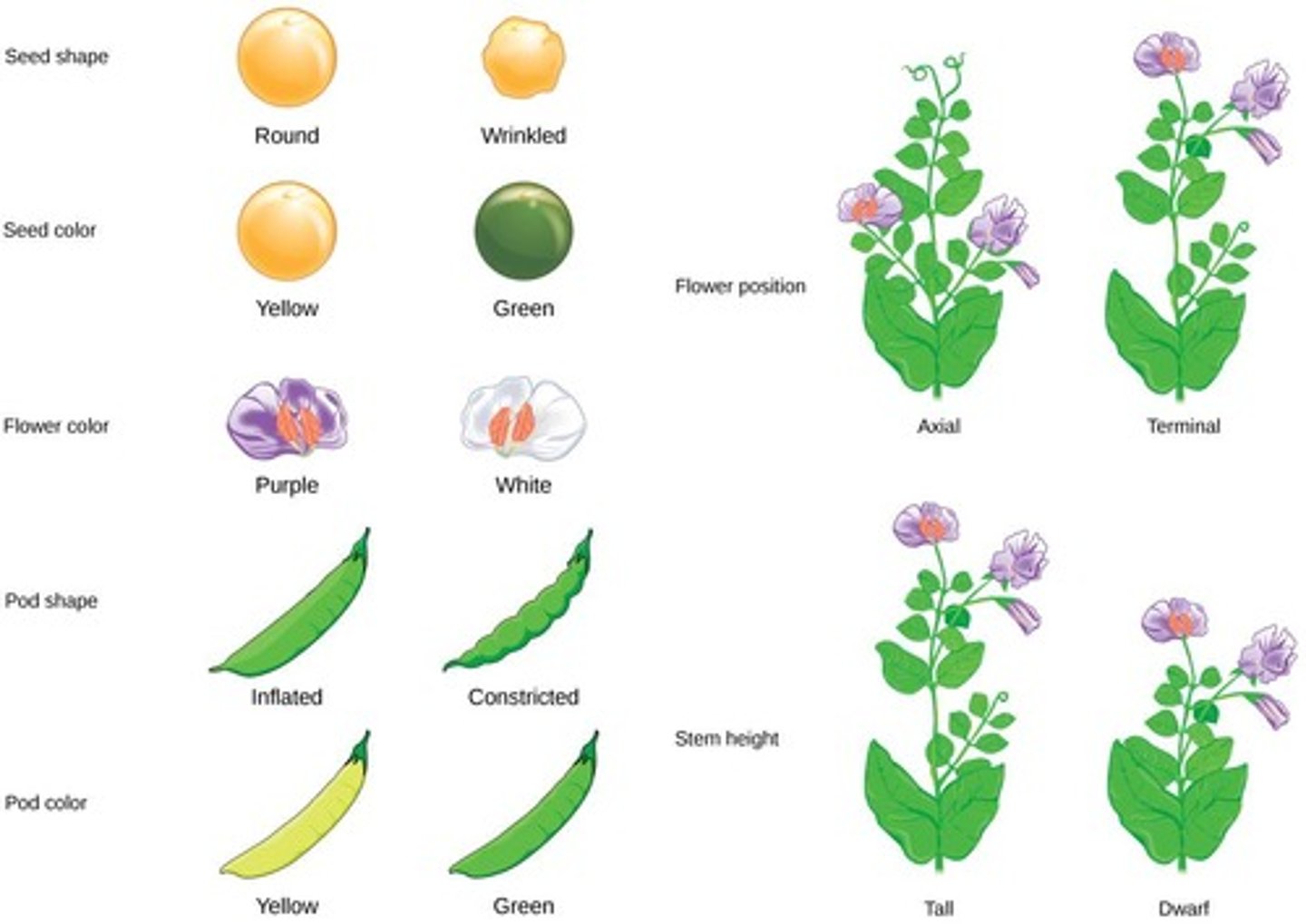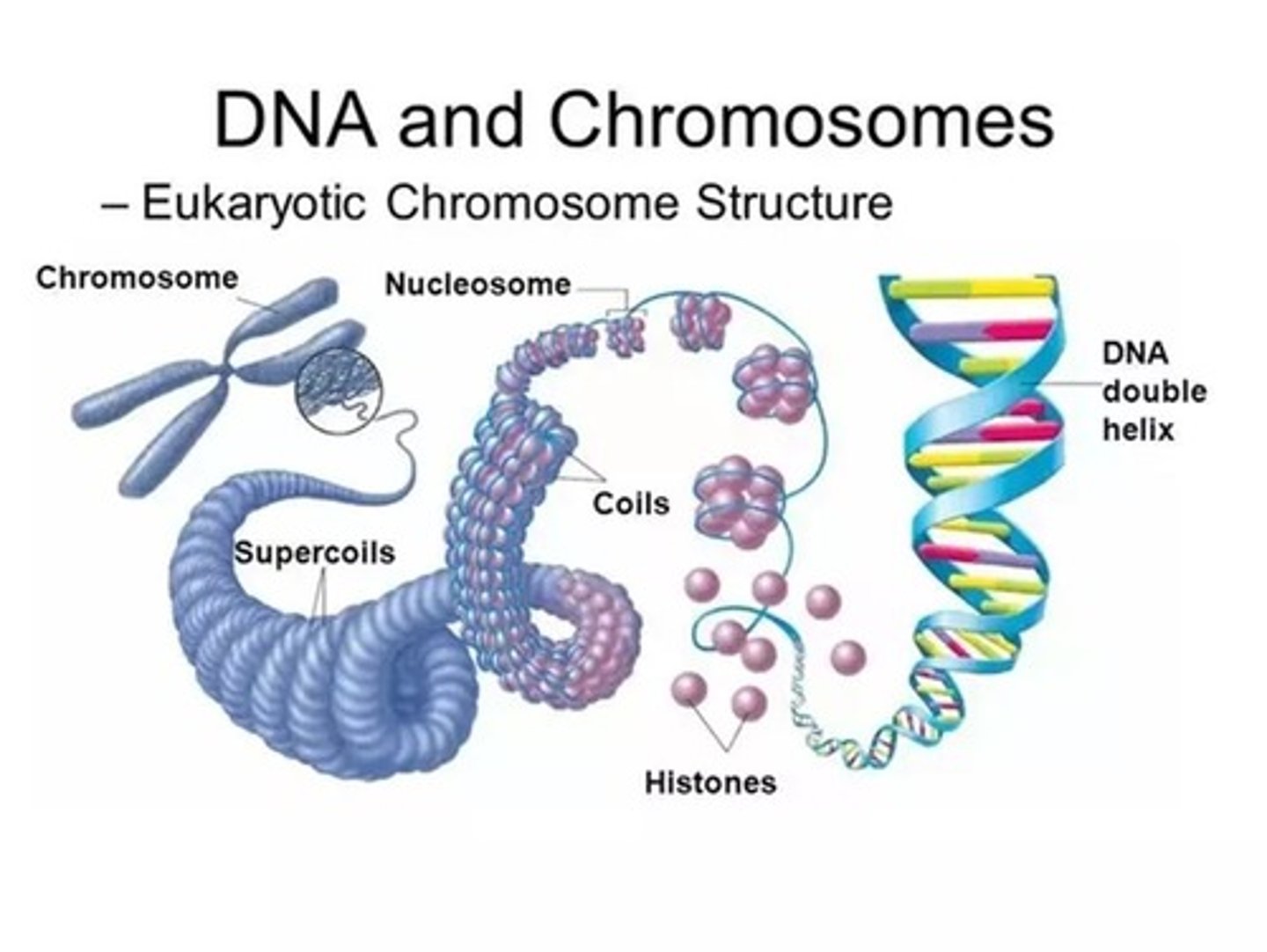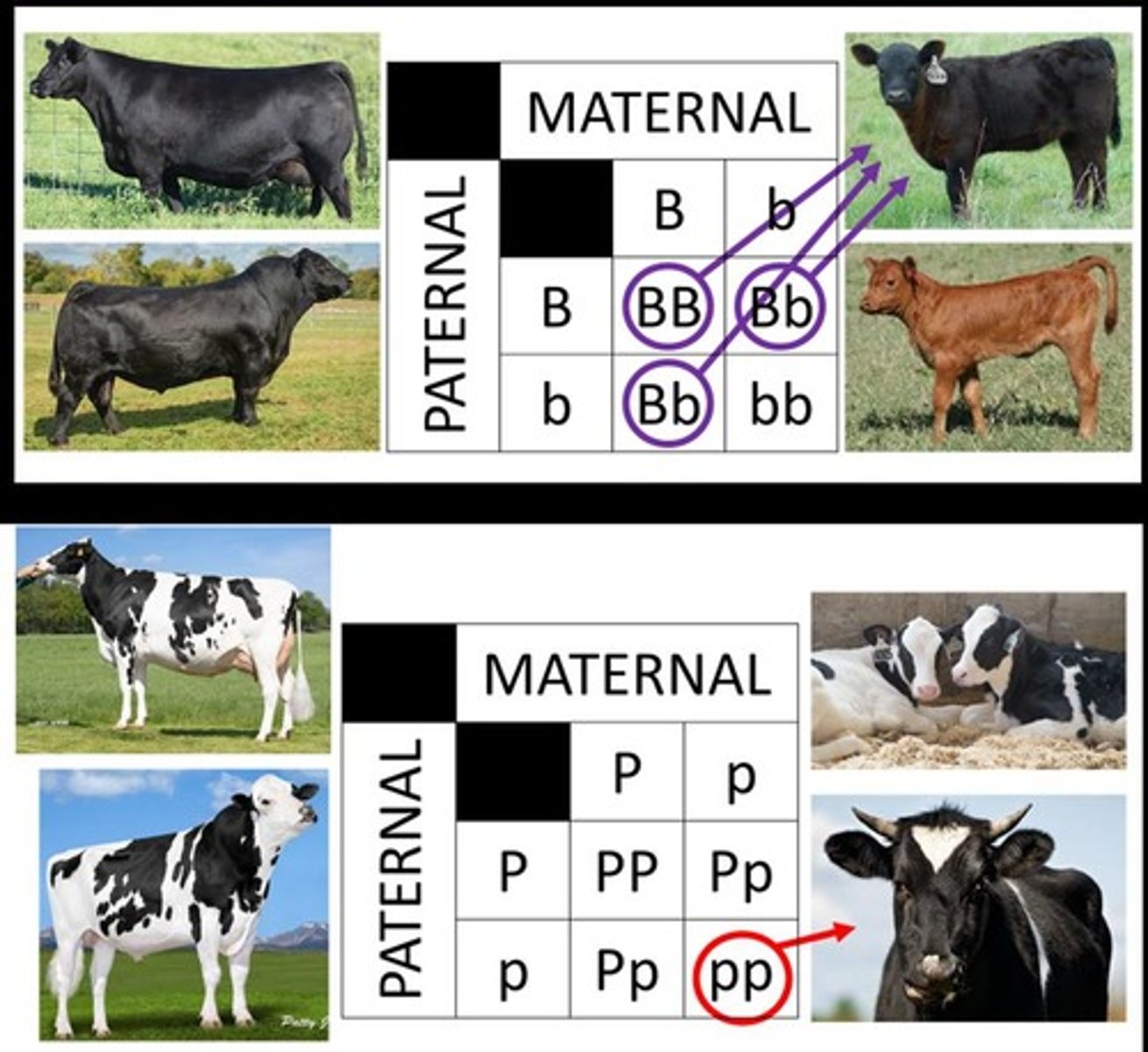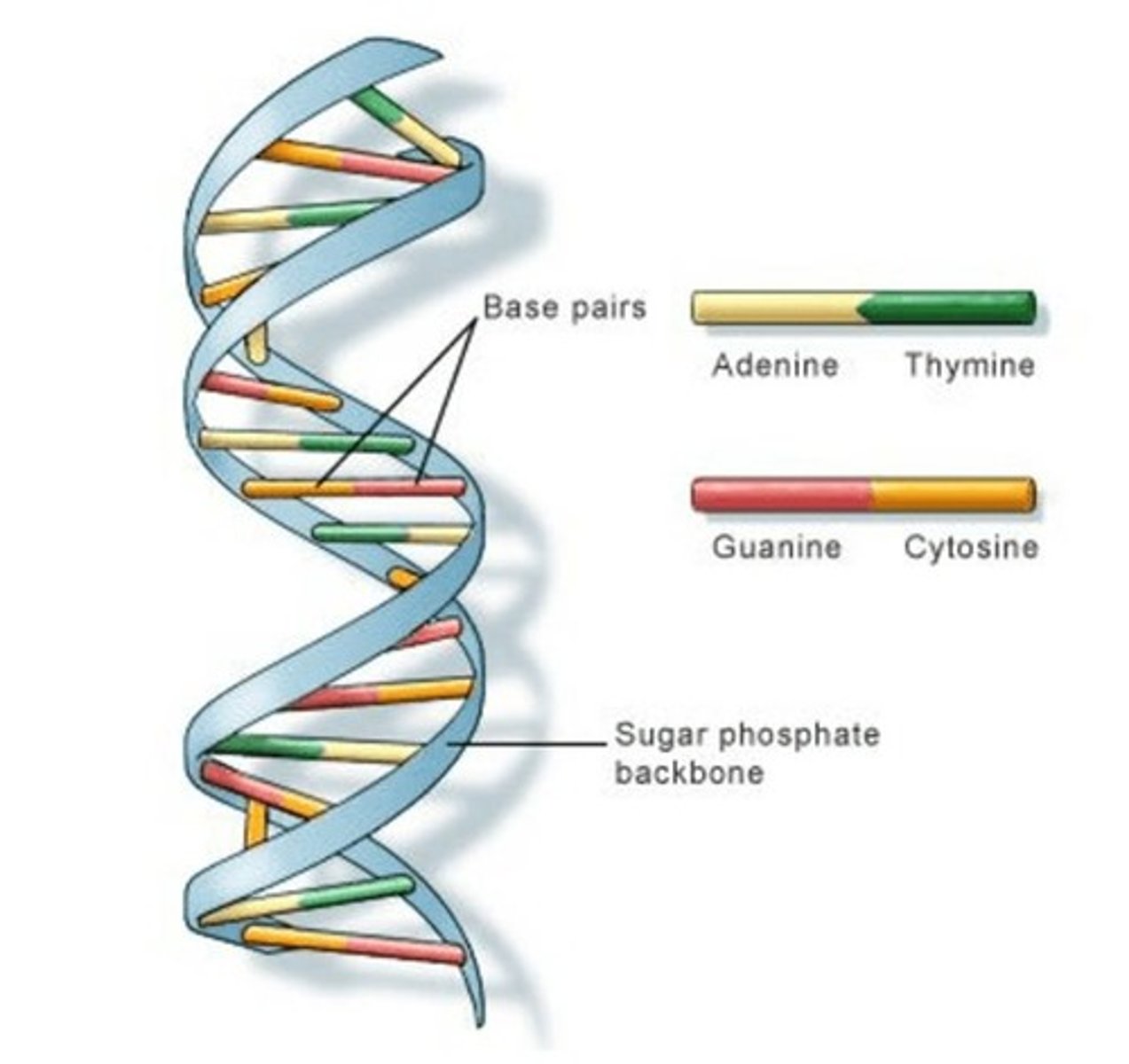Principles of Genetics in Animal Breeding
1/115
There's no tags or description
Looks like no tags are added yet.
Name | Mastery | Learn | Test | Matching | Spaced |
|---|
No study sessions yet.
116 Terms
Genetics
The scientific study of genes, genetic variation, and heredity.
Trait
A distinguishing quality or characteristic.
Artificial selection
Human-guided mating decisions.
Blending theory
Parental essence blends together resulting in the appearance of their offspring being intermediate.
Qualitative traits
Traits that can be placed into categories (i.e. horned OR polled).
F₁ generation
The resulting offspring from the first cross of two parent plants.
F₂ generation
The resulting offspring from self-pollination of the F₁ generation.
Mendel's conclusions
1. Expressed traits: inherited unchanged in a hybridization (dominant phenotype). 2. Latent traits: disappear in the offspring of a hybridization (recessive phenotype). 3. Because the recessive trait reappears in progeny of F₁, the traits remained separate. 4. Plants must have 2 copies of an 'element' but only pass one 'element' on to offspring. 5. Dominant appearance could mean the plant had 2 dominant 'elements' or a dominant and recessive element. 6. Plants exhibiting a recessive appearance lacked a dominant 'element'.
Mendel's pea plants
Results of Mendel's breedings.

3/4
The ratio of plants produced with purple flowers in the F₂ generation.
1/4
The ratio of plants produced with white flowers in the F₂ generation.
Gregor Mendel
Father of modern genetics.
Observed qualitative traits
Traits of pea plants that can be categorized.
Dominant phenotype
The phenotype that is expressed in the presence of a dominant allele.
Recessive phenotype
The phenotype that is expressed only in the absence of a dominant allele.
Element
A term used by Mendel to describe the genetic factors passed from parents to offspring.
Hybridization
The process of crossing two different varieties or species.
Progeny
The offspring produced from a particular cross.
Intermediate appearance
The phenotype that results from blending theory, where offspring exhibit characteristics that are a blend of the parents.
Observed traits
The traits that are visible in the offspring.
Continuous improvement
An understanding of genetics is vital for enhancing livestock species.
Deoxyribonucleic acid
Self replicating material present in nearly all living organisms
Deoxyribonucleic acid
Carries genetic information
Deoxyribonucleic acid
Comprised of nucleotides
Chromosomes
Tightly coiled packages of SOME of an organism's DNA

Genome
The entire "set" of DNA
Genome
Hereditary instructions for building, running, and maintaining an organism
Regions of DNA
DNA has coding and non-coding regions
Non-coding regions
Known as spacer DNA
Coding regions of DNA
Known as genes
Genes
Functional unit of heredity
Genes
Small region of DNA that codes for a functional molecule (i.e. a protein)
Locus (loci)
Specific location on a specific chromosome where a gene is found
Allele
Alternative form of a gene
Allele
Chemical/functional difference between them
Alleles of Extension gene in dogs
More than two alleles can be present in a population
Allele pairings
If an individual possesses two of the same alleles they are said to be homozygous
Homozygous
If an individual possesses two of the same alleles
Heterozygous
If an individual possesses two different alleles
Phenotype
Physical expression of the genotype
Punnett Square
2-dimensional grid used to determine the possible genotypes (and resulting phenotypes) from a mating

Mendel's law of dominance
A certain allele will be dominant over another
Dominant allele
Will express its phenotype and mask the phenotype of the other
Recessive allele
Will be represented with a lowercase letter
Partial dominance
The heterozygous organisms possess a phenotype that is intermediate to the homozygous genotypes
No dominance
The heterozygous organisms possess a phenotype that is exactly intermediate to the phenotypes of the homozygous organisms
20 sec ¼ mile time
A specific time measurement for running a quarter mile.
Co-dominance
The heterozygous organisms fully express the phenotypes of both homozygous genotypes.
Dahlia 'Carnival'
Another example of co-dominance.
Epistasis
The expression of genes at one locus depends on the alleles present at one or more other loci.
Extension gene
Determines if a horse will be black or red; black is dominant (BB and Bb genotypes).
Agouti gene
Restricts black pigment to the points; restriction to the points is dominant (AA and Aa genotypes).
Simply-inherited traits
Traits that are controlled by one - a handful of genes, tend to be categorical (either/or) and are not really affected by the environment.
Polygenic traits
Controlled by hundreds-thousands of different genes, tend to be quantitative (continuous), and are affected by the environment.
Phenotype
The observable characteristics of an organism, which is a result of the genotype and environment.
Genotype
The genetic constitution of an organism.
Carcass weight
Influenced by 100 genes, resulting in 200 alleles where desirable alleles each add 1 pound to carcass weight.
Birth weight
The weight of an animal at birth, which can be quantified (e.g., 75# or 95#).
Weaning weight
The weight of an animal when it is weaned, which can be quantified (e.g., 785# or 885#).
Yearling weight
The weight of an animal at one year of age, which can be quantified (e.g., 995# or 1050#).
Desirable alleles
Alleles that contribute positively to a trait, such as adding weight to carcass.
Undesirable alleles
Alleles that do not contribute positively to a trait, adding nothing (e.g., +0 pounds).
Greater number of desirable alleles
Animals that perform the best in a trait of interest must have a greater number of desirable alleles for that trait.
Pattern of inheritance
The specific way traits are passed from parents to offspring, including dominance and epistatic interactions.
Evaluate performance
Assessing animals based on their traits of interest to determine genetic potential.
Genotype Yearling weight
1065#
Environmental effect
-70#
Phenotype Yearling weight
995#
Genotype Yearling weight
1045#
Environmental effect
+5#
Phenotype Yearling weight
1050#
Performance
Phenotype is affected by genotype and environment.
Genetic potential
An animal will not reach its genetic potential if ideal conditions aren't met.
Heritability
The extent of the effect of environment on performance depends on the heritability of the trait.
Chromosomes
Segments of densely compacted DNA.
DNA
Self-replicating material present in nearly all living organisms.

Genes
Functional unit of heredity.
Locus
Specific location on a specific chromosome where genes are found.
Alleles
Multiple forms of a gene.
Polygenic inheritance
Affected by hundreds to thousands of genes.
Economically important traits
We have to rely on how animals perform in that trait to assess their value as a genetic parent.
Heritability values range
0 - 1 (proportion).
Lowly heritable traits
0 - 0.2 (reproductive traits: fertility, litter size).
Moderately heritable traits
0.2 - 0.4 (growth traits: birth, weaning, yearling weights).
Highly heritable traits
0.4 - 0.6 (carcass traits: HCW, REA, WBSF, marbling).
Phenotype formula
Phenotype = Genotype + Environment.
Estimated breeding values (EBVs)
Values that indicate genetic potential based on performance data.
Expected progeny differences (EPDs)
Values that indicate the expected performance of offspring.
Estimated transmitting abilities (ETAs)
Values that indicate the genetic potential passed to offspring.
Performance records
Extensive record-keeping typically done in seedstock operations.
Expected progeny differences example
Calves sired by Bull A will be 12.5 lbs. heavier at birth than calves sired by Bull D.
Mating plans
Can be based on randomness, performance/visual appearance (phenotype), or genetic relationship (pedigree).
Random mating plan
Selecting which animals are going to be bred without selecting the breeding pairs.
Gate-cutting
The first 25 females to enter a pasture.
Chute-cutting
The first 25 females that go through the chute.
Performance-based mating plans
Involves positive and negative assortative mating.
Positive assortative mating
Breeding animals of the same type of quality to create exceptional offspring.
Negative assortative mating
Breeding animals of opposite (dissimilar quality) to correct poor performance in a trait.
Corrective mating
Also called negative assortative mating, it involves breeding my worst females to my best male.
Inbreeding
Mating closely related animals, increasing homozygosity and the likelihood of expressing detrimental homozygous recessive traits.